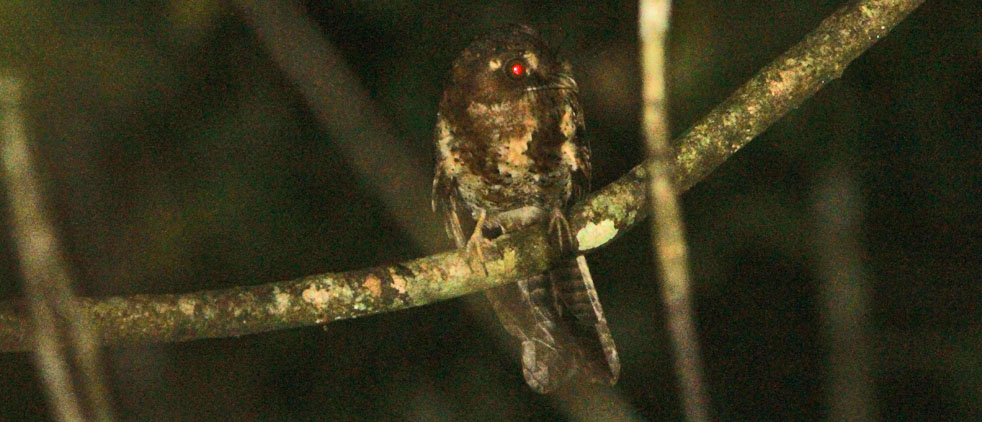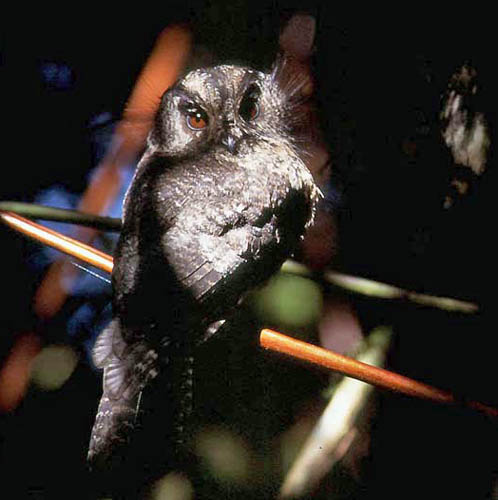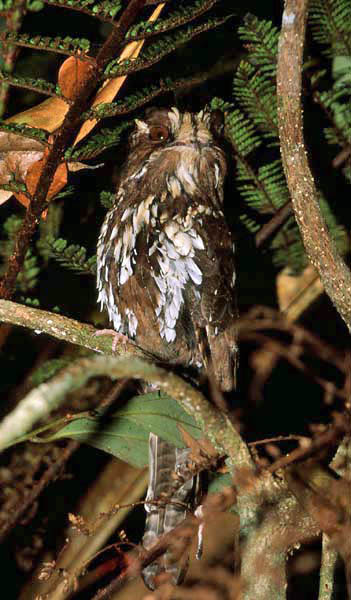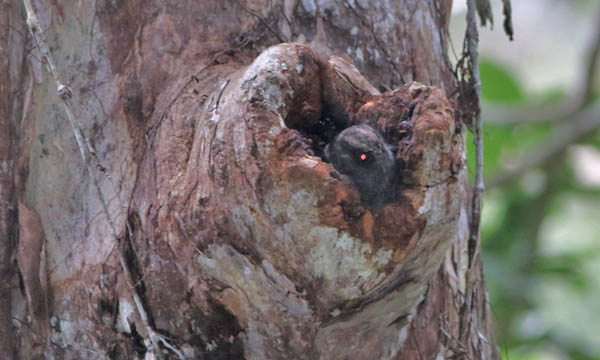| |
OWLET-NIGHTJARS Aegothelidae |
- 10 species in Australasia & New Caledonia
- DR personal total: 4 species (40%), 3 photo'd
|
 The Owlet-Nightjars are a small group of nocturnal birds found only in Australasia — and on New Caledonia if that taxa is not extinct — and all are in the same genus (Aegotheles). One species is fairly widespread in open country of Australia and southern New Guinea: Australian Owlet-nightjar (left). The Owlet-Nightjars are a small group of nocturnal birds found only in Australasia — and on New Caledonia if that taxa is not extinct — and all are in the same genus (Aegotheles). One species is fairly widespread in open country of Australia and southern New Guinea: Australian Owlet-nightjar (left).
This particular individual was found day-roosting in mallee country of northern Victoria, Australia, but I've seen another near dusk when flushed from a roost hole. In this respect the owlet-nightjars remind me of the small scops-owls and screech-owls. Like those owls, these species seem to be actually quite common but very nocturnal. If found at all without special directions or tapes, they are located at day-roosts. It seems remarkable to me that I found three day-roosting owlet-nightjars (one in Australia, two in New Guinea) in my first three visits to Australia and New Guinea — perhaps it is just "time in the field." In contrast to bird tours, where one is herded around and follows a guide, when on a self-guided birding trip you may be in the field all day, every day, and might eventually run into day-roosting night bird. Finding this day-roosting owlet-nightjar was totally unplanned and startling!
On a bird tour, I did photograph Moluccan Owlet-nightjar at night (below). It had responded to a brief snippet of tape and landed in front of our group briefly on Halmahera Island, Indonesia |
 |

My two day-roosting owlet-nightjars in New Guinea were both Mountain Owlet-nightjar (right; great photo by Will Betz of a day-roosting individual he located; I did not get a photo of either of my day-roost finds). Note how the gray-patterned plumage of this owlet-nightjar recalls a scops-owl or a screech-owl. My New Guinea finds also illustrated another parallel: the bird seen in Papua New Guinea was gray (as in Will Betz's photo) but one one found in a tangle at high elevation in the Arfak Mountains, Papua, Indonesia, was red. Thus, like many scops-owls and Eastern Screech-Owl Megascops asio, some owlet-nightjars have red and gray color morphs. And, like the small owls, they nest in hollows and stumps, laying eggs on the bare floor.
As we saw just above, the Moluccan Owlet-nightjar occurs on Halmahera and Bacan in the Moluccas, Indonesia. It is the largest species in the family but is very little known.
The tenth species was apparently rediscovered in 1998 after it had been thought to be extinct for 120 years: New Caledonian Owlet-nightjar A. savesi. It is now known from just two old specimens, plus the 1998 probable sighting, and a handful of unconfirmed reports (Tobias & Ekstrom 2002). Between 2002—2007, many hours were expended in organized searches but no more recent evidence was obtained. The species is either rare or it may be extinct. |
 |
One would suspect the family arose in New Guinea since 7 of the 9 known-to-be-extant species occur there, and at four are specialized in the higher mountains: Mountain, Archbold's A. archboldi, Starry A. tatei, and the exquisitely named Feline Owlet-nightjar (left, in another great photo by Will Betz). Wallace's Owlet-nightjar A. wallacii is a species of hills and mid-elevations.
Vogelkop Owlet-nightjar A. affinis is (apparently) a lowland and hill species, recently split for the more widespread lowland owlet-nightjar in eastern New Guinea: Barred Owlet-nightjar (below). The nominate race of Barred (subspecies bennettii) is basically a bird of lowland rainforest, monsoon forest, and forest edges. Two of its current subspecies, though, are hill or montane birds, and the taxonomy of these is not yet understood. This photo is taken at a well-known day-roost on a college campus near Port Moresby.

|
|
 |
Sibley & Ahlquist (1990) place the owlet-nightjars between the owls and the frogmouths, presumably on DNA-DNA hybridization evidence, but more recent molecular evidence places them as the family in order Caprimulgiformes that is closest to swifts (Mariaux & Braun 1996, Hackett et al. 2008, Braun & Huddleston 2009).
Australian Owlet-nightjar (above, this time in a fine night-time photo by Murray Lord) resides in wide range of habitats in Australia (including Tasmania) and the lowlands of southern New Guinea: taller scrublands such as mallee, trees along watercourses, open woodlands of Eucalyptus and Acacia, and some tropical woodlands. It is presumably resident and territorial in most places. If feeds mostly by sallying from a perch to to take insects on the wing, or from tree-trunks, or occasionally from the ground. It has been said to be more active on moonlit nights than on moonless ones (Cleere 1999). |
| |
Photos: The day-roosting Australian Owlet-nightjar Aegotheles cristatus was in Wyperfeld NP, Australia, on 11 Nov 1983. The Moluccan Owlet-nightjar A. crinifrons was near Foli, Halmahera, Indonesia on 11 Oct 2011. Will Betz photographed the Mountain Owlet-nightjar A. albertisi high in the mountains (8000' elev.) of the Huon Peninsula, Papua New Guinea, in July 1997, and he photographed the Feline Owlet-nightjar A. insignis on the Huon Peninsula, Papua New Guinea, in July 1997. The Barred Owlet-nightjar A. bennettii was at a day roast near Port Moresby, Papuan New Guineas, on 5 Sep 2016. Murray Lord photographed the Australian Owlet-nightjar A. cristatus at Bowra Station, Queensland, Australia, on 29 Sep 2010.
All photos © Don Roberson, except those photo credited © Will Betz and Murray Lord, and used with permission; all rights reserved.
Family Book: 
Cleere, Nigel. 1998. Nightjars: A Guide to the Nightjars, Nighthawks, and their Relatives. Pica Press, London [co-published in U.S. by Yale Univ. Press, New Haven CT]
At first glance this is an extremely attractive book covering the nightjars plus potoos, frogmouths, and owlet-nightjars. In the usual Pica Press format it has a short introduction, a sheaf of color plates illustrating all species, and then the bulk of the book is devoted to detailed species account and range maps. Much emphasis goes into lengthy descriptions and a discussion of field identification and, where known, vocalizations [it was published with a separately purchased CD]. The illustrations are by Dave Nurney. These may be fine for the Old World but, alas, the artwork of birds I know — although attractive — doesn't look much like them [e.g., Common Poorwill much to pale gray rather than rich brown-gray; Pauraque next to Poorwill is way too small; perched nighthawks much too "front-loaded"].
When I started looking up stuff I knew in the text, I found numerous errors and/or omissions. The maps look wonderfully detailed and would lead one to believe they are thus accurate, when, in fact, they are among the worst maps in any family book. The arizonae race of Whip-poor-will is shown nesting throughout California north to Pt. Reyes (!), and the nominate eastern race “wintering” in southern California and Arizona. In truth, Whip-poor-wills of the southwestern race summer on a very few isolated mountains in southern California and are an extremely rare vagrant north of these southwestern mountains. Some or all of the ranges of at least four nightjars in Gabon are omitted (Mozambique C. fossii, Freckled C. tristigma, Black-shouldered C. nigriscapularis, and Bates's C. batesi; I've seen them all in Gabon). The pertinent information is in print (e.g., Sargeant 1993, Christy & Clarke 1994) but was apparently overlooked. If one cannot trust accounts of birds that one knows, how can the reader rely on statements about birds one doesn't know? The disappointing Whip-poor-will map was fixed by the time Cleere (1999) wrote the nightjar account for the HBW series, but some of the other errors persist in that work as well. We thus still lack an authoritative text on these families, but such a book is in the works in the Oxford Press series, as I understand it. It is said to be authored by David Holyoak who did such a nice job with the Frogmouths and Owlet-Nightjars in the Handbook of the Birds of the World, Vol. 5.
[Note: this review was written in 2000, and while owlet-nightjars are covered in this book, the review addresses nightjars primarily.]
Family Book: 
Holyoak, D.T. 2001. Nightjars and their Allies: The Caprimuliformes. Bird Families of the World, No. 7. Oxford Univ. Press, Oxford.
This was the book I had hoped for when I posted the first edition of this page back in 2000. I was disappointed in the Pica Press family book (reviewed above) but this one, in the Oxford Press series, appears to be the authoritative text when it appeared in 2001. It is twice as thick and much heavier that the Pica Press book, and the species accounts are much more substantial. The literature on caprimulgids appears to have been thoroughly searched. The illustrations by Martin Woodcock, grouped together in the middle of the tome, are all of nightjars at roost on the ground, even those species that more routinely roost in trees (e.g., Common Nighthawk, Salvadori's Nightjar C. pulchellus). These are nicely done but the printed colors seem to me to be a bit too bright for many species [Common Poorwill looks the right color, though, in contrast to the Pica Press book]. There are black-and-white flight sketches for all species but, frankly, they are quite standardized and underwhelming. The text seems solid. The errors that annoyed me in the Pica Press book are gone from this production. Although the Oxford book did not anticipate the split of Whip-poor-will into two species, the localized nature of occasional breeding in southern California mountains was accurately set out for what is now Mexican Whip-poor-will Antrostomus arizonae, as was the vagrant nature of such birds in northern California [yet, as a negative, the range map still misrepresents the California range]. The four nightjars that the Pica Press book overlooked for Gabon are correctly mapped in this effort. Indeed, Holyoak even cites me for the "curious potoo-like upright stance" of a Bates's Nightjar in Gabon.
Now, reviewing this book 20 years later, one notices things that were not adequately anticipated, including multiple taxonomic changes. At the Order level, the Caprimuliformes are now found very early in the evolutionary sequence of the birds, far from the former spot about midway in the lists. At the genus level, Holyoak did explain that genetic evidence had already shown that Caprimulgus was polyphyletic, and would likely be split into additional genera (e.g., New World species are now in multiple genera). At the species level, the then "Grey Nightjar C. indicus" has become three species: Jungle Nightjar C. indicus, Gray Nightjar C. jotaka, and Palau Nightjar C. phalaena). Most world lists use the wonderful name Diabolical Nightjar for Eurostopodus diabolicus but Holyoak went with the mundane "Henrich's Nightjar." Notwithstanding the passage of time, and multiple changes in taxonomy, nightjars remain comparatively little-known birds. This compendium of knowledge, compiled as it was some 20 years ago, is surely still the standard for a stand-alone family book, consistent with the Oxford Press series as a whole.
[Note: this review was written in 2002, and while owlet-nightjars are covered in this book, the review addresses nightjars primarily. This review was briefly updated in 2021, but again the focus was on nightjars — where the review was initially posted — and not owlet-nightjars.]
Literature cited:
Braun, M.J., and C.J. Huddleston. 2009. A molecular phylogenetic survey of caprimulgiform nightbirds illustrates the utility of non-coding sequences. Molec. Phylog. Evol. 53: 948–960.
Cleere, N. 1998. Nightjars: A Guide to the Nightjars, Nighthawks, and their Relatives. Pica Press, London
Coates, B.J., and K.D. Bishop. 1997. A Guide to the Birds of Wallacea. Dove Publ., Alderly, Qld., Australia.
Hackett, S.J., R.T. Kimball, S. Reddy, R.C. Bowie, E.L. Braun, M.J. Braun, J.L. Chojnowski, W.A. Cox, K.L. Han, J. Harshman, C.J. Huddleston, B.D. Marks, K.J. Miglia, W.S. Moore, F.H. Sheldon, D.W. Steadman, C.C. Witt, and T. Yuri. 2008. A phylogenomic study of birds reveals their evolutionary history. Science 320: 1763–1768.
Holyoak, D.T. 1999. Family Caprimulgidae (Owlet-nightjars), pp. 252–265 in Handbook of the Birds of the World (del Hoyo, J., J. Elliott, & J. Sargatal, eds). Vol. 5. Lynx Edicions, Barcelona.
Holyoak, D.T. 2001. Nightjars and their Allies: The Caprimuliformes. Bird Families of the World, No. 7. Oxford Univ. Press, Oxford.
Mariaux, J., and M.J. Braun. 1996. A molecular phylogenetic survey of the nightjars and allies (Caprimulgiformes) with special emphasis on the potoos (Nyctibiidae). Molec. Phylog. Evol. 6: 228–244.
Sibley, C.G., and J.E. Ahlquist. 1990. Phylogeny and Classification of Birds: a Study of Molecular Evolution. Yale Univ. Press, New Haven, CT.
Tobias, J.A., and J.M.M. Ekstrom. 2002. The New Caledonian Owlet-nightjar Aegotheles savesi rediscovered? Bull. Brit. Orn. Club. 122: 282–285.
|
|
|



 The Owlet-Nightjars are a small group of nocturnal birds found only in Australasia — and on New Caledonia if that taxa is not extinct — and all are in the same genus (Aegotheles). One species is fairly widespread in open country of Australia and southern New Guinea: Australian Owlet-nightjar (left).
The Owlet-Nightjars are a small group of nocturnal birds found only in Australasia — and on New Caledonia if that taxa is not extinct — and all are in the same genus (Aegotheles). One species is fairly widespread in open country of Australia and southern New Guinea: Australian Owlet-nightjar (left). 



